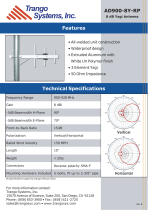
iv Enterprise Wireless LAN Antenna Specification Guide
53-1001881-01
Chapter 3 2.4 GHz Single Band Antenna Suite
Supported 802.11b/g/n antenna suite . . . . . . . . . . . . . . . . . . . . . .13
ML-2499-5PNL-72-N Outdoor 135° Panel Antenna: male connector
14
ML-2499-7PNA2-01R Indoor 60° Diversity Panel: RP-BNC male16
ML-2499-11PNA2-01R Outdoor 97°Sector Panel: RP-BNC male18
ML-2499-APA2-01R Indoor Rubber Flex, Elbow Joint Dipole: RP-BNC
male . . . . . . . . . . . . . . . . . . . . . . . . . . . . . . . . . . . . . . . . . . . . . . .20
ML-2499-BPDA1-01R Outdoor 10°High-Gain Dish: 20.5 N female22
ML-2499-BPNA3-01R Outdoor 35° High-Gain Directional Panel: type
N - female . . . . . . . . . . . . . . . . . . . . . . . . . . . . . . . . . . . . . . . . . . .24
ML-2499-BYGA2-01R Outdoor 35° High-Gain Directional Yagi:
N female . . . . . . . . . . . . . . . . . . . . . . . . . . . . . . . . . . . . . . . . . . . .26
ML-2499-HPA3-01R High Performance Omni-Directional “Pipe”
Antenna: RP-BNC male . . . . . . . . . . . . . . . . . . . . . . . . . . . . . . . .28
ML-2499-PNAHD-01R Indoor 55°Directional Panel: RP-BNC male30
ML-2499-SD3-01R Low Profile Ceiling/Surface Mount Omni-
Directional Patch: RP-BNC male . . . . . . . . . . . . . . . . . . . . . . . . .32
ML-2499-FHPA5-01R Omni-Directional “Pipe” Antenna: N male
connector . . . . . . . . . . . . . . . . . . . . . . . . . . . . . . . . . . . . . . . . . . .34
ML-2499-FHPA9-01R High Performance Fixed Point Dipole: male
connector . . . . . . . . . . . . . . . . . . . . . . . . . . . . . . . . . . . . . . . . . . .36
Chapter 4 5.2 Ghz Single Band Antenna Suite
Supported 802.11a/n antenna suite . . . . . . . . . . . . . . . . . . . . . . . .39
ML-5299-APA1-01R Indoor Rubber Flex Jointed Dipole: RP-SMA male
connector . . . . . . . . . . . . . . . . . . . . . . . . . . . . . . . . . . . . . . . . . . .40
ML-5299-HPA1-01R High Performance Omni-Directional Dipole
Antenna: RP-SMA male connector . . . . . . . . . . . . . . . . . . . . . . .42
ML-5299-PTA1-01R Low Profile Ceiling-Tile Mount Patch: RP-SMA
male connector . . . . . . . . . . . . . . . . . . . . . . . . . . . . . . . . . . . . . .44
ML-5299-WPNA1-01R Wall Mount Panel Antenna w/Articulating
Mount: RP-SMA male. . . . . . . . . . . . . . . . . . . . . . . . . . . . . . . . . .46
ML-5299-FHPA10-01R Omni-Directional “Pipe” Antenna: N male
connector . . . . . . . . . . . . . . . . . . . . . . . . . . . . . . . . . . . . . . . . . . .48
ML-5299-FHPA6-01R Omni-Directional “Pipe” Antenna: N male
connector . . . . . . . . . . . . . . . . . . . . . . . . . . . . . . . . . . . . . . . . . . .50
Chapter 5 2.4GHz - 5.2GHz Dual Band Antenna Suite
Supported 802.11a/b/g/n Dual Band Antennas . . . . . . . . . . . . . . .53
ML-2452-APA2-01 Indoor Dual Band Elbow Jointed Dipole: RP-SMA
male . . . . . . . . . . . . . . . . . . . . . . . . . . . . . . . . . . . . . . . . . . . . . . .54
ML-2452-PNA5-01R Dual Band Panel: Connector Type N male56
ML-2452-PNA7-01R Dual Band Panel: Connector Type N-Male59
ML-2452-PTA2M3X3-1 AP-7131 MIMO Facade: 1 IN, RPSMA 62
ML-2452-PTA3M3-036 Ceiling Mount, Dual Band, MIMO Patch:
RPSMA . . . . . . . . . . . . . . . . . . . . . . . . . . . . . . . . . . . . . . . . . . . . .65




















